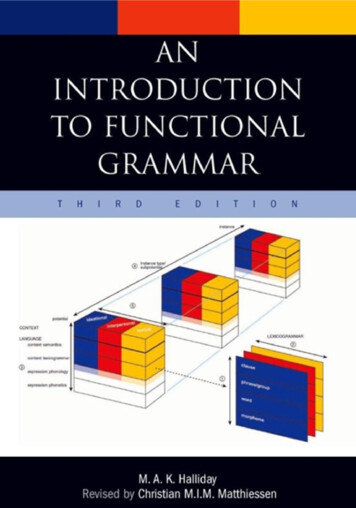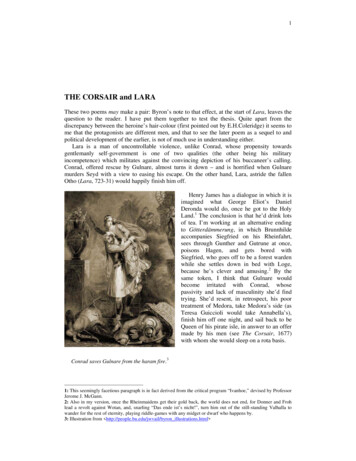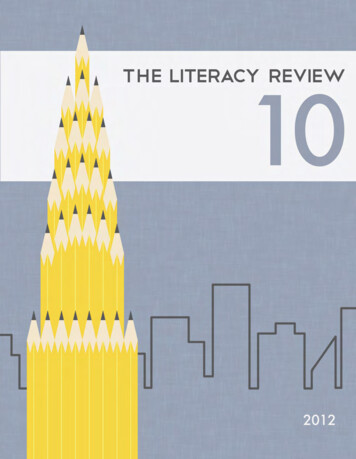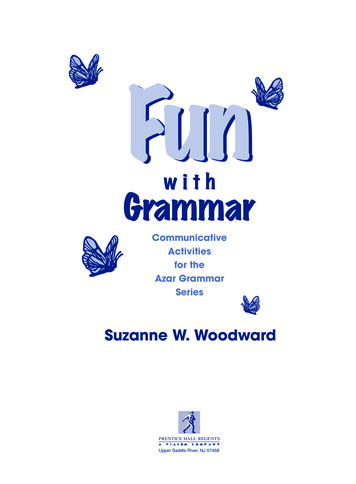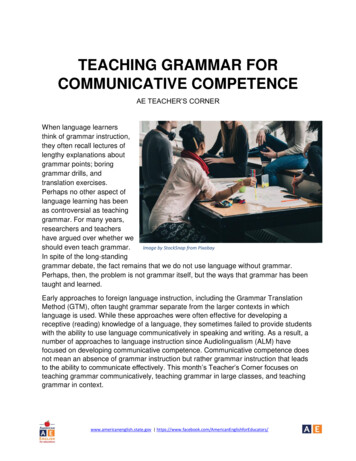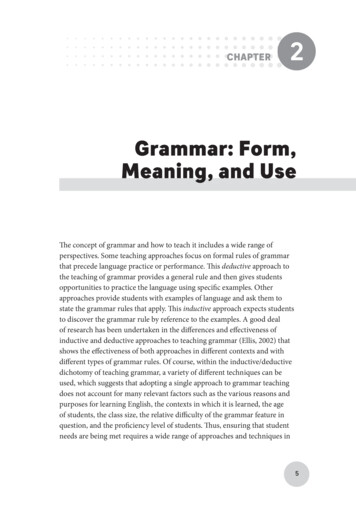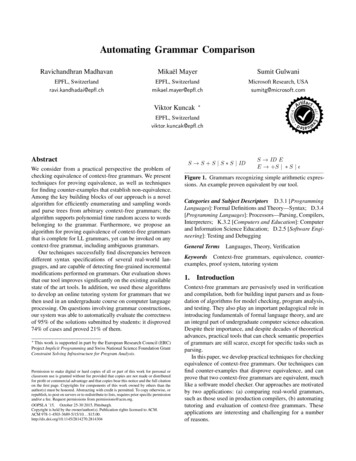
Transcription
Automating Grammar ComparisonRavichandhran MadhavanMikaël MayerSumit GulwaniEPFL, Switzerlandravi.kandhadai@epfl.chEPFL, Switzerlandmikael.mayer@epfl.chMicrosoft Research, USAsumitg@microsoft.comseeusistPS L AO O * C on ** Easy toedRntat e d*Permission to make digital or hard copies of all or part of this work for personal orclassroom use is granted without fee provided that copies are not made or distributedfor profit or commercial advantage and that copies bear this notice and the full citationon the first page. Copyrights for components of this work owned by others than theauthor(s) must be honored. Abstracting with credit is permitted. To copy otherwise, orrepublish, to post on servers or to redistribute to lists, requires prior specific permissionand/or a fee. Request permissions from permissions@acm.org.OOPSLA ’15, October 25-30 2015, Pittsburgh.Copyright is held by the owner/author(s). Publication rights licensed to ACM.ACM 978-1-4503-3689-5/15/10. . . 15.00.http://dx.doi.org/10.1145/2814270.2814304S S S S S IDumework is supported in part by the European Research Council (ERC)Project Implicit Programming and Swiss National Science Foundation GrantConstraint Solving Infrastructure for Program Analysis.* CompleteWe Thistifact*We consider from a practical perspective the problem ofchecking equivalence of context-free grammars. We presenttechniques for proving equivalence, as well as techniquesfor finding counter-examples that establish non-equivalence.Among the key building blocks of our approach is a novelalgorithm for efficiently enumerating and sampling wordsand parse trees from arbitrary context-free grammars; thealgorithm supports polynomial time random access to wordsbelonging to the grammar. Furthermore, we propose analgorithm for proving equivalence of context-free grammarsthat is complete for LL grammars, yet can be invoked on anycontext-free grammar, including ambiguous grammars.Our techniques successfully find discrepancies betweendifferent syntax specifications of several real-world languages, and are capable of detecting fine-grained incrementalmodifications performed on grammars. Our evaluation showsthat our tool improves significantly on the existing availablestate of the art tools. In addition, we used these algorithmsto develop an online tutoring system for grammars that wethen used in an undergraduate course on computer languageprocessing. On questions involving grammar constructions,our system was able to automatically evaluate the correctnessof 95% of the solutions submitted by students: it disproved74% of cases and proved 21% of them.tenC *AE ll Doc EvEPFL, Switzerlandviktor.kuncak@epfl.chAbstractAralu *Viktor KuncakS ID EE S S Figure 1. Grammars recognizing simple arithmetic expressions. An example proven equivalent by our tool.Categories and Subject Descriptors D.3.1 [ProgrammingLanguages]: Formal Definitions and Theory—Syntax; D.3.4[Programming Languages]: Processors—Parsing, Compilers,Interpreters; K.3.2 [Computers and Education]: Computerand Information Science Education; D.2.5 [Software Engineering]: Testing and DebuggingGeneral Terms Languages, Theory, VerificationKeywords Context-free grammars, equivalence, counterexamples, proof system, tutoring system1.IntroductionContext-free grammars are pervasively used in verificationand compilation, both for building input parsers and as foundation of algorithms for model checking, program analysis,and testing. They also play an important pedagogical role inintroducing fundamentals of formal language theory, and arean integral part of undergraduate computer science education.Despite their importance, and despite decades of theoreticaladvances, practical tools that can check semantic propertiesof grammars are still scarce, except for specific tasks such asparsing.In this paper, we develop practical techniques for checkingequivalence of context-free grammars. Our techniques canfind counter-examples that disprove equivalence, and canprove that two context-free grammars are equivalent, muchlike a software model checker. Our approaches are motivatedby two applications: (a) comparing real-world grammars,such as those used in production compilers, (b) automatingtutoring and evaluation of context-free grammars. Theseapplications are interesting and challenging for a numberof reasons.
S A S IntA Int, A IntS Int GG Int G , Int A A , Int A Int GFigure 2. Grammars defining well-formed function signatures over Int. An example proven equivalent by our tool.(a)S A Int IntA S, Int Int(b)S A S IntA S, S IntFigure 3. Grammars subtly different from the grammarsshown in Fig. 2. The grammar on the left does not accept“Int Int Int".Programming Language Grammars. Much of the frontends of modern compilers and interpreters are automaticallyor manually derived from grammar-based descriptions ofprogramming languages, more so with integrated languagesupport for domain specific languages. When two compilersor other language tools are built according to two differentreference grammars, knowing how they differ in the programsthey support is essential. Our experiments show that twogrammars for the same language almost always differ, evenif they aim to implement the same standard. For instance, wefound using our tool that two high quality standard Javagrammars (namely, the Java grammar1 used by Antlr v4parser generator [1], and the Java language specification[2]) disagree on more than 50% of words that are randomlysampled from them.Even though the differences need not correspond to incompatibilities between the compilers that use these grammars(since their handling could have been intentionally delegatedto type checkers and other backend phases), the sheer volumeof these discrepancies does raise serious concerns. In fact,most deviations found by our tool are not purposeful. Moreover, in the case of dynamic languages like Javascript, whereparsing may happen at run-time, differences between parserscan produce diverging run-time behaviors. Our experimentsshow that (incorrect) expressions like “ RegExp - this"discovered by our tool while comparing Javascript grammarsresult in different behaviors on Firefox and Internet Explorerbrowsers, when the expressions are wrapped inside functionsand executed using the eval construct (see section 5).Besides detecting incompatibilities, comparing real-worldgrammars can help identify portions of the grammars that areoverly permissive. For instance, many real-world Java grammars generate programs like “enum ID implements char{ ID }", “private public class ID" (which were discovered while comparing them with other grammars). Theseimprecisions can be eliminated with little effort without compromising parsing efficiency.Furthermore, often grammars are rewritten extensivelyto make them acceptable by parser generators, which is la1 .g4borious and error prone. Parser generators have become increasingly permissive over the years to mitigate this problem.However, there still remains considerable overhead in thisprocess, and there is a general need for tools that pin-pointsubtle changes in the modified versions (documented in workssuch as [33]). It is almost always impossible to spot differences between large real-world grammars through manualscanning, because the grammars typically appear similar, andeven use the same name for many non-terminals. A challengethis paper addresses is developing techniques that scales toreal-world grammars, which have hundreds of non-terminalsand productions.Grammars in Teaching. An equally compelling application of grammar comparison arises from the importance ofcontext-free grammar in computer science education. Assignments involving context-free grammars are hard to gradeand provide feedback on because of the great variation inthe possible solutions arising due to the succinctness of thegrammars. The complexity is further aggravated when thesolutions are required to belong to subclasses like LL(1). Forexample, Figures 1 and 2 show two pairs of grammars thatare equivalent. The grammars shown on the right are LL(1)grammars, and are reference solutions. The grammars shownon the left are intuitive solutions that a student comes upwith initially. Proving equivalence of these pairs of grammarsis challenging because they do not have any similarity intheir structure, but recognize the same language. On the otherhand, Figure 3 shows two grammars (written by students)that subtly differ from the grammars of Fig. 2. The smallestcounter-example for the grammar shown in Fig. 3(a) is thestring “Int Int Int". We invite the readers to identifya counter-example that differentiates the grammar of Fig. 3(b)from those of Fig. 2.In our experience, a practical system that can prove that astudent’s solution is correct and provide a counter-exampleif it is not can greatly aid tutoring of context-free grammars.The state of the art for providing feedback on programmingassignments is to use test cases (though there has been recentwork on generating repair based feedback [29]). We bring thesame fundamentals to context-free grammar education. Furthermore, we exploit the large, yet under-utilized, theoreticalresearch on decision procedures for equivalence of contextfree grammars to develop a practical algorithm that can provethe correctness of solutions provided by the students.Overview and Contributions. At the core of our system isa fast approach for enumerating words and parse trees of anarbitrary context-free grammar, which supports exhaustiveenumeration as well as random sampling of parse treesand words. These features are supported by an efficientpolynomial time random access operation that constructs aunique parse tree for any given natural number index. Weconstruct a scalable counter-example detection algorithm byintegrating our enumerators with a state-of-the-art parsingtechnique [25].
We develop and implement an algorithm for proving equivalence by extending decision procedures for subclasses ofdeterministic context-free grammars to arbitrary (possiblyambiguous) context-free grammars, while preserving soundness. We make the algorithm practical by performing numerous optimizations, and use concrete examples to guide theproof exploration. We are not aware of any existing systemthat supports both proving as well as disproving of equivalence of context-free grammars. The following are our maincontributions: We present an enumerator for generating parse trees of ar-bitrary context-free grammars that supports the followingoperations: 1) a polynomial time random access operationlookup(i, l) that given an index i returns the unique parsetree generating a word of length l, corresponding to theindex, and 2) sample(n, l) that generates n uniformlyrandom samples from the parse trees of the grammar generating words of length l (Section 2). We use the enumerators to discover counter-examples forequivalence of context-free grammars (Section 3). We integrate and extend the algorithms of Korenjak andHopcroft [15], Olshansky and Pnueli [24], and Harrisonet al. [12], for proving equivalence of LL context-freegrammars to arbitrary context-free grammars. Our extensions are sound but incomplete. We show using experiments that the algorithm is effective on many grammarsthat lie outside the classes with known decision procedures (Section 4). We evaluate the counter-example detection algorithm on10 real-world grammars describing the syntax of 5 mainstream programming languages. The algorithm discoversdeep, fine-grained errors, by finding counter-exampleswith an average length of 35, detecting almost 3 timesmore errors than a state-of-the-art approach (Section 5). We implement and evaluate an online tutoring system forcontext-free grammars. Our system is able to decide theveracity of 95% of the submissions, detecting counterexamples in 74% of the submissions, and proving correctness of 21% of the submissions (Section 6).2.Enumeration of Parse Trees and WordsA key ingredient of our approach for finding counterexamples is enumeration of words and parse trees belongingto a context-free grammar. Enumeration is also used in optimizing and improving the scope of our grammar equivalenceproof engine. We model our enumerators as functions fromnatural numbers to objects that are enumerated (which areparse trees or words), as opposed to viewing them as iterators for a sequence of objects as is typical in programminglanguage theory. The enumerators we propose are bijectivefunctions from natural numbers to parse trees in which theimage and pre-image of any given value is efficiently com-putable in polynomial time (formalized in Theorem 1). Thefunctions are partial if the set that is enumerated is finite.Using bijective functions to construct enumerators has manyadvantages, for example, it immediately provides a way ofsampling elements from the given set. It also ensures thatthere is no duplication during enumeration. Additionally, thealgorithm we present here can be configured to enumerateparse trees that generate words having a desired length.Notations. A context-free grammar is a quadruple(N, Σ, P, S), where N is a set of non-terminals, Σ is a setof terminals, P N (N Σ) is a finite set of productions and S N is the start symbol. A parse tree belongingto a grammar is a labelled tree with internal nodes labelledby non-terminals, and leaves labelled by terminals, that hasthe property that if an internal node labelled A has childrenlabelled C1 , · · · , Cn (from left to right) then A C1 · · · Cn .Let T denote the set of parse trees belonging to a grammar.We refer to sequences of terminals and non-terminalsbelonging to (N Σ) as sentential forms of the grammar.If a sentential form has only terminals, we refer to it as aword, and also sometimes as a string. We adopt the usualconvention of using greek characters α, β etc. to representsentential forms and upper-case latin characters to representnon-terminals. We use lower-case latin characters a, b, c etc.to represent terminals and w, x, y etc. to denote words. Wesay that α derives β in one step, denoted α β, iff β isobtained by replacing the left most non-terminal in α by oneof its right-hand-sides. Let denote the reflexive transitiveclosure of . The language recognized by a sentential formα, denoted L(α), is the set of words that can be derived fromα i.e, L(α) {w Σ α w}. We introduce morenotations as they are needed.2.1Constructing Random Access EnumeratorsWe use Enum[α] : N T to denote an enumerator for asentential form α of the input grammar. The enumerators arepartial functions from natural numbers to tuples of parse treesof the grammar, one rooted at every symbol in the sententialform. For brevity, we refer to the tuple as parse trees ofsentential forms. We define Enum[α] recursively followingthe structure of the grammar as explained in the sequel.For a terminal a belonging to a grammar, Enum[a] isdefined as {0 leaf (a)}. That is, the enumerator for aterminal a maps the first index to a parse tree with a single leafnode containing a and is undefined for every other index. Wenow describe an enumerator for a non-terminal. Consider fora moment the non-terminal S of the grammar shown in Fig. 4.The parse trees rooted at S are constructed out of the parsetrees that belong to the non-terminal A and the sententialform BA. Assume that we have enumerators defined for Aand BA, namely Enum[A] and Enum[BA] that are functionsfrom natural numbers to parse trees (a pair of them in thecase of BA). Our algorithm constructs an enumerator for Scompositionally using the enumerators for A and BA.
SAB A BAa aSb t {a, b}. Enum[t](i) leaf (t) if i 0 A {S, A, B}. Enum[N ](i) node(S, Enum[α](j)), where (α, j) Choose[S](i)Enum[BA](i) (Enum[B](j), Enum[A](k)) where (j, k) π(i, , )Enum[aS](i) (Enum[a](j), Enum[S](k)) where (j, k) π(i, 1, )Figure 4. An example grammar and illustrations of the Enum functions for the symbols of the grammar. Choose and π aredefined in Fig. 6 and Appendix A, respectively.τ (α) n 1Yτ (Mi ), where α M0 · · · Mn 1 , n 1i 0τ (A) n 1Xτ (αi ), where A α0 · · · αn 1i 0τ (a) 1, where a ΣChoose[A](i) let A α0 · · · αn 1 s.t. 1 m n. #t(αm 1 ) #t(αm ) inlet b0 0, and b1 , · · · , bn #t(α0 ), · · · , #t(αn 1 ) inlet 0 m n. im bm (n m 1) m 1Xbi ini 0Figure 5. Equations defining the number of parse trees ofsentential forms. #t is the greatest fix-point of the equations.Recall that we consider enumerators as bijective functionsfrom natural numbers. So, given an index i we need to define aunique parse tree of S corresponding to i (provided i is withinthe number of parse trees rooted at S). To associate a parsetree of S to an index i, we first need to identify a right-handside α of S and select a parse tree t of the right-hand-side. Todetermine a parse tree t of the right-hand-side α, it sufficesto determine the index of t in the enumerator for α. Hence,we define a function Choose[A] : N ((N Σ) N)for every non-terminal A, that takes an index and returns aright-hand-side of A, and an index for accessing an elementof the right-hand-side. We define the enumerator for a nonterminal as: Enum[A](i) node(A, Enum[α](j)), where(α, j) Choose[A](i). That is, as a node labelled A andhaving the tuple Enum[α](j) as children.In the simplest case, if A has n right-hand-sidesα0 , α2 , · · · , αn 1 , the choose function Choose[A](i) couldbe defined as (αi%n , bi/nc). This definition, besides beingsimple, also ensures a fair usage of the right-hand-sides of Aby mapping successive indices to different right-hand-sides,which ensures that any sequence of enumeration of the wordsbelonging to a non-terminal alternates over the right-handsides of the non-terminal. However, this definition is welldefined only when every right-hand-side of A has unboundednumber of parse trees. For instance, consider the non-terminalA shown in Fig. 4. It has two right-hand-sides a and aS ofwhich a has only a single parse tree. Defining Choose[A] as(αi%2 , bi/2c) is incorrect as, for example, Enum[A](2) mapsto Enum[a](1), which is not defined. Therefore, we extendthe above function so that it takes into account the numberof parse trees belonging to the right-hand-sides, which isdenoted using #t(α).It is fairly straightforward to compute the number of parsetrees of non-terminals and right-hand-sides in a grammar. Forlet k be such that 0 k n 1 and ik i ik 1 inlet q b(i ik )/(n k)c and r (i ik )%(n k) in(αk r , bk q)Figure 6. Choose function for a non-terminal A.completeness, we show a formal definition in Fig. 5. Considerthe recursive equations shown in Fig. 5 of the form τ F (τ )that define a function F from the set (N Σ) (N { })to itself. Let ] be the relation lifted to the domain ofF , i.e, for any τ1 , τ2 , τ1 ] τ2 iff α.τ1 (α) τ2 (α). Thenumber of parse trees #t is the greatest fix-point of F withrespect to the ordering ] . Note that the greatest fix-point canbe computed iteratively starting from the initial value λx. .As shown in the equations, the number of (tuples of) parsetrees of a sentential form is the product of the number ofparse trees of the symbols in the sentential form. The numberof parse trees of a non-terminal is the sum of the number ofparse trees of its right-hand-sides, and the number of parsetrees of a terminal is one. Note that if the grammar has cycles,#t could be infinite for some sentential forms.Fig.6 defines a Choose function, explained below, that canhandle right-hand-sides with a finite number of parse trees.The definition guarantees that whenever Choose returns apair (α, i), i is less than #t(α), which ensures that Enum[α]is defined for i. In Fig.6, the right-hand-sides of the nonterminal A: α0 , · · · , αn 1 , are sorted in ascending order ofthe number of parse trees belonging to them. We define b0 aszero and use b1 , · · · , bn to denote the number of parse treesof the right-hand-sides. (Note that #t(αi ) is given by bi 1 .)The index im is the smallest index (of Enum[A]) at whichthe mth right-hand-side αm becomes undefined, which isdetermined using the number of parse trees of each righthand-side as shown. Given an index i, Choose[A](i) firstdetermines the right-hand-sides that need to be skipped i.e,
whose enumerators are not defined for the index i, by findinga k such that ik i ik 1 . It then chooses a right-handside (namely αj ) from the remaining n k right-hand-sideswhose enumerators are defined for the index i, and computesthe index to enumerate from the chosen right-hand-side.Most of the computations performed by Fig. 6 – suchas computing the number of parse trees of the right-handsides (and hence b0 , · · · , bn ) and the indices i0 , · · · , im ,and sorting the right-hand-sides of non-terminals by theirnumber of parse trees – need to performed once per grammar.Therefore, for each index i, the Choose function may onlyhave to scan through the right-hand-sides to determine thevalue of k, and perform simple arithmetic operations tocompute q and r.Note that the Choose function degenerates to the simpledefinition (αi%n , bi/nc) presented earlier when #t is unbounded for every right-hand-side of N . The function alsopreserves fairness by mapping successive indices to different right-hand-sides of the non-terminals. For instance, inthe case of the non-terminal A shown in Fig. 4, the Choosefunction maps index 0 to (a, 0), index 1 to (aS, 0), but index 2 is mapped to (aS, 1) as a has only one parse tree, i.e,#t(a) 1.We now describe the enumerator for a sentential form αwith more than one symbol. Let α M1 M2 · · · Mm . Thetuples of parse trees belonging to the sentential form is thecartesian product of the parse trees of M1 , · · · , Mm . However, eagerly computing the cartesian product is impossiblefor most realistic grammars because it is either unboundedor untractably large. Nevertheless, we are interested onlyin accessing a tuple at a given index i. Hence, it sufficesto determine for every symbol Mj , the parse tree tj that isused to construct the tuple at index i. The tree tj can be determined if we know its index in Enum[Mj ]. Therefore, itsuffices to define a bijective function π : N Nm that mapsa natural number (the index of Enum[α]) to a point in an mdimensional space of natural numbers. The j th componentof π(i) is the index of Enum[Mj ] that corresponds to the j thparse tree of the tuple. In other words, Enum[M1 · · · Mm ](i)could be defined as (Enum[M1 ](i1 ), · · · , Enum[Mm ](im )),where ij is the j th component of π(i).When m is two, the function π reduces to an inversepairing function that is a bijection from natural numbers topairs of natural numbers. Our algorithm uses only an inversepairing function as we normalize the right-hand-sides of theproductions in the grammar to have at most two symbols. Weuse the well known Cantor’s inverse pairing function [26].But, this function assumes that the two dimension space isunbounded in both directions, and hence cannot be employeddirectly when the number of parse trees generated by thesymbols in the sentential form are bounded. We extend theinverse paring functions to two dimensional spaces that arebounded in one or both the directions. The extended functionstake three arguments, the index that is to be mapped, andPrgmQNameClassDef import QName ; ClassDefID ID . QNameclass { Body }Figure 7. A grammar snippet illustrating the need to boundthe length of the generated words during enumeration.the sizes of the x and y dimensions (or infinity if they areunbounded). We present a formal definition of the functionsin Appendix A.Using the extended Cantor’s inverse pairing function π wedefine the enumerator for a sentential form with two symbolsas: Enum[M1 M2 ](i) (Enum[M1 ](i1 ), Enum[M2 ](i2 )),where (i1 , i2 ) π(i, #t(M1 ), #t(M2 )).Termination of Random Access. Later in section 2.3 wepresent a bound on the running time of the algorithm, butnow we briefly discuss termination. If A is a recursive nonterminal e.g, if it has a production of the form A αAβ,the enumerator for N may recursively invoke itself, eitherdirectly or through other enumerators. However, for everyindex other than 0 and 1, the recursive invocations will alwaysbe passed a strictly smaller index. This follows from thedefinition of the Choose and the inverse pairing functionsused by our algorithm. (In the case of the inverse pairingfunction, if π(i) (j, k), j and k are strictly smaller than ifor all i 1). For indices 0 and 1 the recursive invocationsmay happen with the same index. However, this will not resultin non-termination if the following properties are ensured: (a)for every non-terminal, the right-hand-side chosen for index0 is the first production in the shortest derivation startingfrom the non-terminal and ending at a word. (b) There are nounproductive non-terminals (which are non-terminals that donot generate any word) in the input grammar.From Parse Trees to Words. We obtain enumerators forwords using the enumerators for parse trees by mapping theenumerated parse trees to words. However, when the inputgrammar is ambiguous, the resulting enumerators are nolonger bijective mappings from indices to words. The numberof indices that map to a word is equal to the number of parsetrees of the word.2.2Enumerating Fixed Length WordsThe enumeration algorithm we have described so far is agnostic to the lengths of the enumerated words. As a consequence,the algorithm may generate undesirably long words, and infact may also favour the enumeration of long words overshorter ones. Fig. 7 shows a snippet from the Java grammarthat results in this behavior.In the Fig. 7, the productions of the non-terminal Body arenot shown for brevity. It generates all syntactically correctbodies allowed for a class in a Java program. Consider theenumeration of the words (or parse trees) belonging to thenon-terminal Prgm starting from index 1. A fair enumerationstrategy, such as ours, will try to generate almost equal num-
SB a BS b(a)S3S2S1B1 B1 S2 B2 S1B1 S1ab(b)Figure 8. (a) An example grammar. (b) the result of restricting the grammar shown in (a) to words of size 3.[[N ]]l [[N α1 ]]l · · · [[N αn ]]l ,where N α1 , · · · αn([[N a]]l [[N AB]]l {Nl a} l 1[if l 1otherwise({Nl Ai Bl i } [[A]]i [[B]]l i )i 1Figure 9. Transforming non-terminals and productions of agrammar to a new set of non-terminals and productions thatgenerate only words of length l.ber of words from the non-terminals QName and ClassDef.However, the lengths of the words generated for the sameindex differ significantly between the non-terminals. For instance, the word generated from the non-terminal QName atan index i has length i 1. On the other hand, the lengthsof the words generated from the non-terminal ClassDef growslowly relative to their indices, since it has many right-handsides, and each right-hand-side is in turn composed of nonterminals having many alternatives. In essence, the wordsgenerated for the non-terminal Prgm will have long importdeclarations followed by very short class definitions.Moreover, this also results in reduced coverage of rulessince the enumeration heavily reuses productions of QName,but fails to explore many alternatives reachable throughClassDef. We address this issue by extending the enumerationalgorithm so that it generates only parse trees of words havinga specified length. We accomplish this by transforming theinput grammar in such way that it produces only stringsthat are of the required length, and use the transformedgrammar in enumeration. The idea behind the transformationis quite standard. For instance, previous works [14], [19] ontheoretical algorithms for random sampling of unambiguousgrammars also resort to a similar approach. However, whatis unique to our algorithm is using the transformation toconstruct bijective enumerators while guaranteeing randomaccess property for all words of the specified length.Fig. 8 illustrates this transformation on an example, whichis explained in detail below. For explanatory purposes, assume that the input grammar is in Chomsky’s Normal Form(CNF) [16] which ensures that every right-hand-side of thegrammar is either a terminal or has two non-terminals.Fig. 9 formally defines the transformation. For every nonterminal N of the input grammar, the transformation createsa non-terminal Nl that generates only those words of Nthat have a length l. The productions of Nl are obtained bytransforming the productions of N . For every production ofthe form N a, where a is a terminal, the transformationcreates a production Nl a if l 1. For every productionof the form N AB that has two non-terminals on theright-hand-side, the transformation considers every possibleway in which a word of size l can be split between thetwo non-terminals, and creates a production of the formNl Ai Bl i for each possible split (i, l i). Additionally,the transformation recursively produces rules for the nonterminals Ai and Bl i . The transformed grammar may haveunproductive non-terminals and rules that do not generateany word (like the non-terminal B2 and rule S3 B2 S1 ofFig. 9(b)), and hence may have to be simplified. Observe thatthe transformer grammar is acyclic and generates only a finitenumber of parse trees.This transformation increases the sizes of the right-handsides by a factor of l, in the worst case. For efficiency reasons,we construct the productions of the transformed grammaron demand, when it is required during the enumeration ofa parse tree. Therefore, the functions Enum and Choose takethe length of the word to be enumerated as an additionalparameter.Sampling Parse Trees and Words. Having constructed enumerators with the above characteristics, it is straightf
veracity of 95% of the submissions, detecting counter-examples in 74% of the submissions, and proving correct-ness of 21% of the submissions (Section 6). 2. Enumeration of Parse Trees and Words A key ingredient of our approach for finding counter-examples is enumeration of words and parse trees belonging to a context-free grammar.


